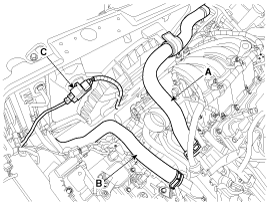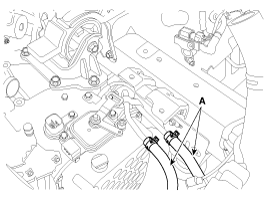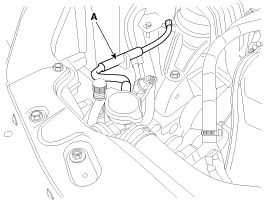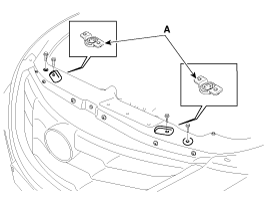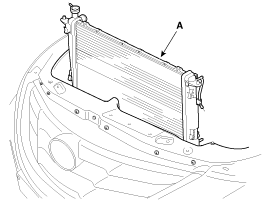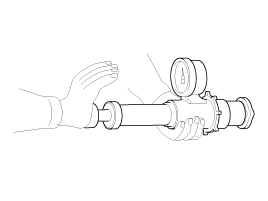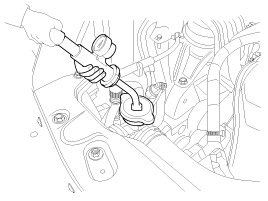 Hyundai Sonata: Radiator. Repair procedures
Hyundai Sonata: Radiator. Repair procedures
Removal and Installation
| 1. |
Disconnect the battery terminals.
(Refer to Engine and transaxle assembly in this group)
|
| 2. |
Remove the air cleaner assembly.
(Refer to Engine and transaxle assembly in this group)
|
| 3. |
Remove the battery and battery tray.
(Refer to Engine and transaxle assembly in this group)
|
| 4. |
Remove the under cover.
(Refer to Engine and transaxle assembly in this group)
|
| 5. |
Loosen the drain plug, and drain the engine coolant.
Remove the radiator cap to drain with speed.
|
| 6. |
Disconnect the radiator upper hose (A), lower hose
(B) and then disconnect the fan motor connector (C).
|
| 7. |
Disconnect the ATF cooler hoses (A/T only).
(Refer to AT group)
|
| 8. |
Disconnect the over flow hose (A) from the radiator.
|
| 9. |
Remove the cooling fan assembly (A).
|
| 10. |
Remove the radiator mounting bracket (A).
|
| 11. |
Separate the condenser from the radiator and then
remove the radiator assembly (A).
|
| 12. |
Installation is the reverse order of removal.
|
| 13. |
Fill the radiator with coolant and check for leaks.
|
Inspection
| 1. |
Remove the radiator cap, wet its seal with engine
coolant, and then install it on a pressure tester.
|
| 2. |
Apply a pressure of 93.16 ~ 122.58 kPa (0.95 ~ 1.25
kgf/cm², 13.51 ~ 17.78 psi).
|
| 3. |
Check for a drop in pressure.
|
| 4. |
If the pressure drops, replace the cap.
|
| 1. |
Wait until engine is cool, then carefully remove
the radiator cap and fill the radiator with engine coolant, then install
it on the pressure tester.
|
| 2. |
Apply a pressure tester to the radiator and apply
a pressure of 93.16 ~ 122.58kPa (0.95 ~ 1.25kgf/cm², 13.51 ~ 17.78psi).
|
| 3. |
Inspect for engine coolant leaks and a drop in pressure.
|
| 4. |
Remove the tester and reinstall the radiator cap.
|
 Radiator. Components and Components Location
Radiator. Components and Components Location
Components
1. Cooling fan assembly
2. Radiator
3. Mounting insulator
4. Radiator mounting bracket
5. Radiator upper hose
6. Radiator lower hose
7. Reservo ...
 Water pump. Components and Components Location
Water pump. Components and Components Location
Components
1. Water pump pulley
2. Water pump
3. Water pump gasket
4. Water pump housing
5. Water pump housing gasket
6. O-ring
7. Water inlet pipe
8. ...
See also:
Steering Angle Sensor. Description and Operation
Description
The Steering Angle Sensor (SAS) is installed in EPS (Electric Power Steering)
and it sends messages to HECU through CAN communication line.
The SAS is used to determine turning ...
Speakers. Repair procedures
Inspection
1.
Troubleshooting for Speaker
(1)
Basic inspection of speaker
Inspect the sound from speaker after verifying that ...
Low tire pressure telltale
When the tire pressure monitoring system warning indicator is illuminated, one
or more of your tires is significantly under-inflated.
If the telltale illuminates, immediately reduce your speed, a ...

